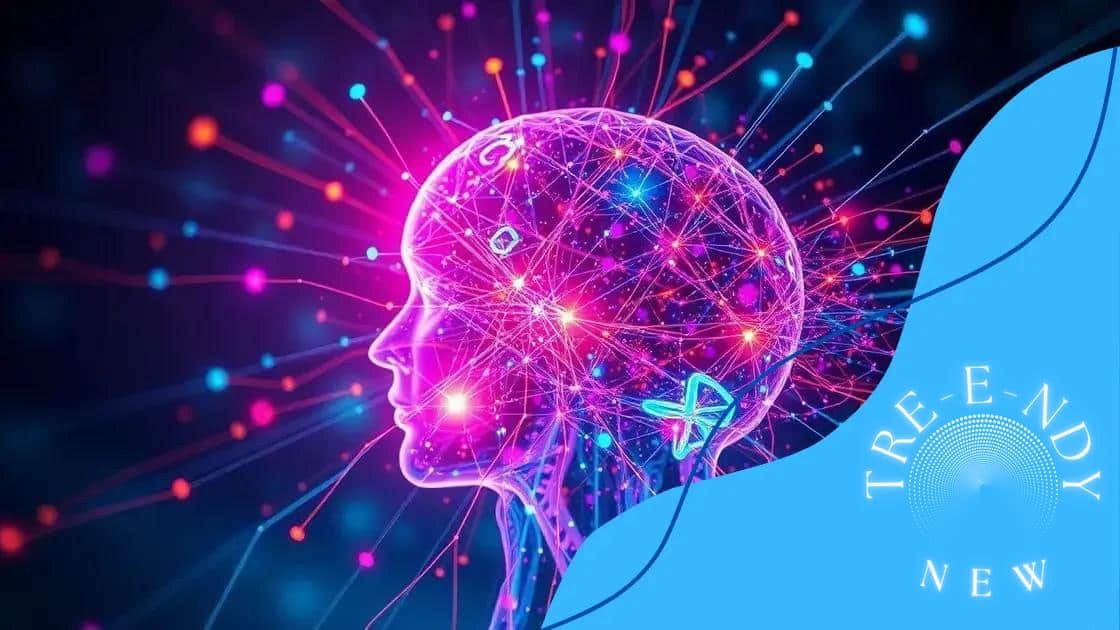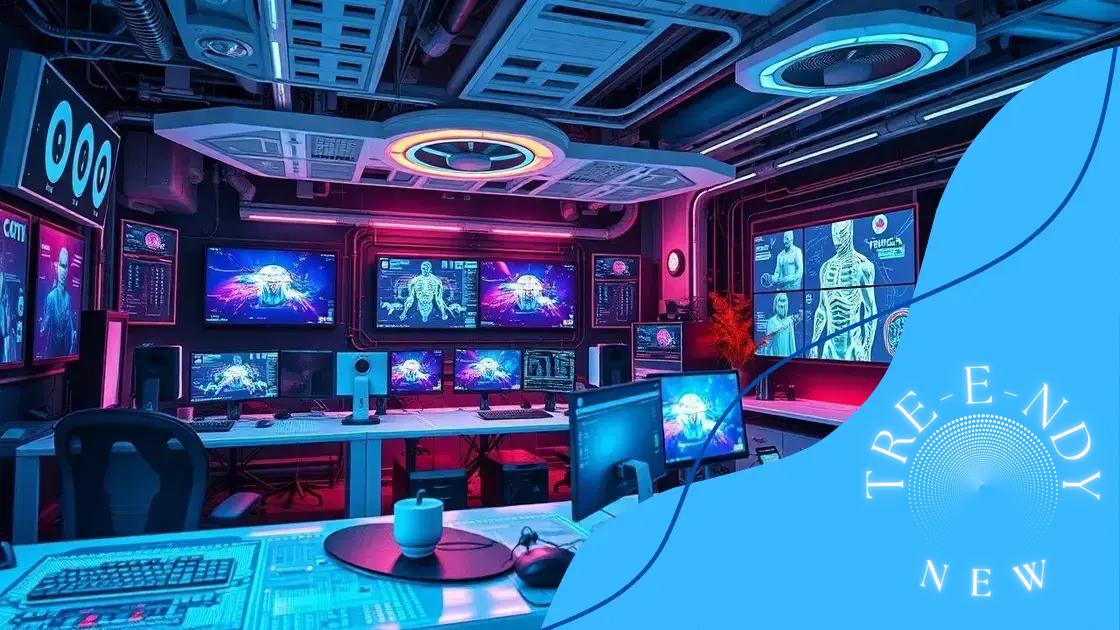The role of AI in transforming the creative industries

The role of AI in transforming the creative industries involves enhancing artistic expression, automating processes, and addressing ethical considerations, while fostering collaboration between technology and human creativity.
The role of AI in transforming the creative industries is undeniable. Have you noticed how technology continuously shapes our artistic landscapes? From music to visual arts, AI is incredibly changing the way creators work.
Impact of AI on artistic expression
The impact of AI on artistic expression is a fascinating topic. Artists today are beginning to explore how artificial intelligence can enhance their creative processes. From painting to music, AI tools are pushing boundaries that were once thought to be impossible.
AI in Visual Arts
With programs like DeepArt and DALL-E, artists can create stunning visuals by simply inputting an idea. These tools use complex algorithms to generate unique images that reflect the input provided. Artists often find themselves in collaboration with AI, leading to innovative results.
- AI can inspire new styles and techniques.
- Artists use AI to explore uncharted territories in creativity.
- Technologies like machine learning expand traditional artistry.
- You don’t have to be a programmer to use these tools.
Moreover, AI tools can analyze existing artworks, offering insights that may inspire artists. This data-driven approach helps artists understand trends and preferences, guiding them in their creative journey. Artists can now blend their intuition with the analytical power of machines.
AI in Music Creation
In the music industry, AI systems are composing songs that resonate with listeners. Applications like Amper Music and AIVA allow musicians to create music quickly. These applications analyze popular music trends to produce tracks that are not only unique but also appealing.
As AI continues to evolve, it opens up new avenues for collaboration in the music industry. Artists can experiment beyond their typical genres, leading to surprising and captivating musical experiences. The synergy between human creativity and AI assistance creates a rich tapestry of sound that was previously unimaginable.
In summary, the impact of AI on artistic expression is profound. Artists now have powerful tools at their disposal, enabling them to innovate and collaborate like never before. The future of creativity is bright, as AI helps artists unlock potential they never knew existed.
AI tools revolutionizing the music industry
AI tools revolutionizing the music industry have changed how we create and experience music. Musicians are now using sophisticated algorithms to compose songs and produce sounds that captivate audiences worldwide. These tools allow for a unique blend of creativity and technology, making music creation more accessible than ever.
Automated Music Composition
Tools like Amper Music and AIVA enable artists to generate original music quickly. These applications analyze trends and patterns in existing music to create fresh, appealing tracks. By simply inputting parameters like mood, genre, or tempo, musicians can receive a full composition tailored to their needs.
- Automated music tools reduce the time required for composition.
- Musicians can explore new genres quickly and easily.
- AIVA can learn from an artist’s style, providing personalized compositions.
- AI tools help break creative blocks by generating ideas.
Additionally, AI is being used for sound design, allowing musicians to create unique samples and effects. Software like LANDR masters tracks using artificial intelligence, offering professional sound quality without the need for extensive knowledge or resources. This democratizes the music production process, enabling even amateur musicians to produce high-quality work.
AI in Music Recommendation
AI is also at the forefront of music recommendation systems. Platforms like Spotify utilize algorithms that analyze user listening habits to curate personalized playlists. These recommendations enhance the listener’s experience by introducing them to new artists and genres they might enjoy, all based on their previous preferences.
As users interact with these platforms, the AI continuously learns, refining its recommendations over time. This creates a dynamic and engaging environment for music discovery. Music listeners can find new favorites without searching extensively, making AI a powerful ally in the way we enjoy music.
In summary, the AI tools revolutionizing the music industry are allowing artists and listeners alike to experience music in exciting new ways. With the collaboration of technology and creativity, the landscape of music continues to evolve, offering endless possibilities for innovation and enjoyment.
The future of content creation with AI

The future of content creation with AI is an exciting topic. As technology continues to evolve, the possibilities for creators are expanding. Artists, writers, and marketers are all finding new ways to utilize AI tools effectively.
Enhancing Creativity with AI
AI is not here to replace artists; instead, it enhances their creative processes. Tools like OpenAI’s ChatGPT assist writers in generating ideas and drafting content. This allows creators to overcome writer’s block and explore diverse themes more freely.
- AI can suggest plot twists and character developments for writers.
- Musicians can collaborate with AI to produce unique sounds.
- Visual artists can use AI-generated designs as inspiration.
- Marketers can analyze data for targeted campaigns effortlessly.
Moreover, AI tools can analyze audience engagement, helping creators understand what resonates with their audience. This data allows for more personalized content, ensuring creators hit the mark with their projects. By adapting their work based on real-time feedback, content creators can enhance their effectiveness and reach.
The Role of AI in Video Production
In video production, AI is streamlining processes that once took hours. Editing software now uses AI to automate tedious tasks like color correction and sound balancing. This makes it easier for creators to focus on storytelling instead of getting bogged down in technical details.
With tools like Lumen5, users can convert text into engaging videos rapidly. This democratizes video production, making it accessible to those who may not have extensive skills in filmmaking. The fusion of AI and creativity is empowering everyone to create compelling visual content.
Looking ahead, the future of content creation with AI holds immense potential. As these technologies become more sophisticated, we can expect a new wave of innovation that challenges traditional boundaries. The collaboration between human creativity and artificial intelligence will inspire even richer content and experiences for audiences across the globe.
Challenges in integrating AI in creative processes
Challenges in integrating AI in creative processes are significant and multi-faceted. As more creators turn to AI tools, they encounter obstacles that can hinder their creative freedom and workflow. Understanding these challenges is essential for a smooth integration of AI into artistic practices.
Understanding AI Limitations
One major challenge is the limitation of AI itself. While AI can generate ideas, it lacks the emotional depth of human creators. Tools that produce music or art sometimes miss the nuances that convey genuine feelings. As a result, relying too heavily on AI can lead to outputs that, while technically impressive, may lack soul.
- AI often struggles with understanding context.
- Generated content can feel formulaic without human input.
- Complex emotional themes are difficult for AI to grasp.
- Artists may find it hard to trust AI-generated work.
Moreover, there is the issue of copyright and ownership. Who owns a piece of art created by an AI? This question poses legal and ethical dilemmas, creating uncertainty for artists who utilize AI in their workflows. As creators navigate these waters, they must also consider how their use of AI may affect their own intellectual property rights.
Balancing Creativity with Technology
Finding a balance between creativity and technology is another hurdle. Many artists fear that AI could stifle their unique voice or style. When AI generates content based on existing patterns, it risks homogenizing artistry. Creators are left to wonder how to incorporate AI without losing their individuality.
Additionally, learning to use AI tools can be overwhelming. Many artists may not have the technical expertise required to harness the full potential of AI software. This can lead to frustration and disengagement, making it essential for education and tutorials to bridge the gap between technology and creative practice.
Ultimately, the challenges in integrating AI into creative processes are complex. From understanding AI’s limitations to grappling with ethical questions, creators must be mindful of how they use these tools to enhance rather than detract from their work. Embracing AI as a collaborative partner rather than a replacement can pave the way for innovative solutions in the creative landscape.
Ethical considerations for AI in the arts
Ethical considerations for AI in the arts are crucial as we navigate this rapidly evolving landscape. As AI tools become more integrated into artistic practices, questions arise regarding the implications of their use. Artists, audiences, and society must grapple with these ethical challenges.
Ownership and Copyright Issues
One major concern is ownership. When an AI creates a piece of art or music, who holds the copyright? Artists risk losing control over their creations if they rely on AI tools. This uncertainty can discourage creators from experimenting with AI, as they may fear their intellectual property could be compromised.
- Understanding legal frameworks is essential for artists.
- Contracts should address AI’s role in the creative process.
- Attribution for AI-generated works remains an unresolved issue.
- Clear guidelines could help protect artists and their rights.
Furthermore, the use of AI in the arts raises questions about authenticity. Some may argue that art created with AI lacks the human touch, leading to debates about what constitutes “true” art. This dilemma challenges creators to think about their motivations and intentions when integrating AI into their work.
Bias and Representation
Another ethical consideration involves bias in AI algorithms. AI systems learn from existing data, which may reflect societal biases. If these biases are not addressed, the resulting art may perpetuate stereotypes or exclude underrepresented voices. Therefore, it is vital for creators and developers to actively work against bias in AI training data.
Artists can play a role in advocating for diverse datasets and promoting inclusivity in AI art. By using AI responsibly, they can help ensure that marginalized perspectives are represented fairly in the creative landscape.
The ethical considerations for AI in the arts are complex and demand ongoing dialogue among artists, technologists, and audiences. As we embrace AI, we must remain vigilant and thoughtful about its implications, ensuring that creativity flourishes alongside the responsible use of technology.
In conclusion, the integration of AI in the creative industries brings numerous opportunities and challenges. As artists embrace these advanced tools, it is essential to consider the ethical implications and the impact on artistic authenticity. By acknowledging issues like copyright, representation, and bias, creators can navigate the complex landscape responsibly. Collaboration between technology and creativity can lead to innovative expressions while ensuring that diverse voices are heard. As we move forward, ongoing dialogue will be vital in shaping the future of art in an AI-driven world.
FAQ – Frequently Asked Questions about AI in the Arts
What are the ethical concerns related to AI in art?
Ethical concerns include ownership and copyright issues, authenticity of AI-generated art, and potential biases in algorithms.
How can AI enhance the creative process for artists?
AI can assist artists by generating ideas, providing new tools for composition, and automating repetitive tasks, thus freeing up time for more creative work.
What challenges do artists face when integrating AI into their work?
Challenges include fear of losing their unique artistic voice, technical skill gaps, and navigating the legal landscape of AI ownership.
Is AI capable of producing truly original art?
While AI can create unique pieces, the originality often depends on the input data and algorithms. It doesn’t possess the emotional depth of human artists.





